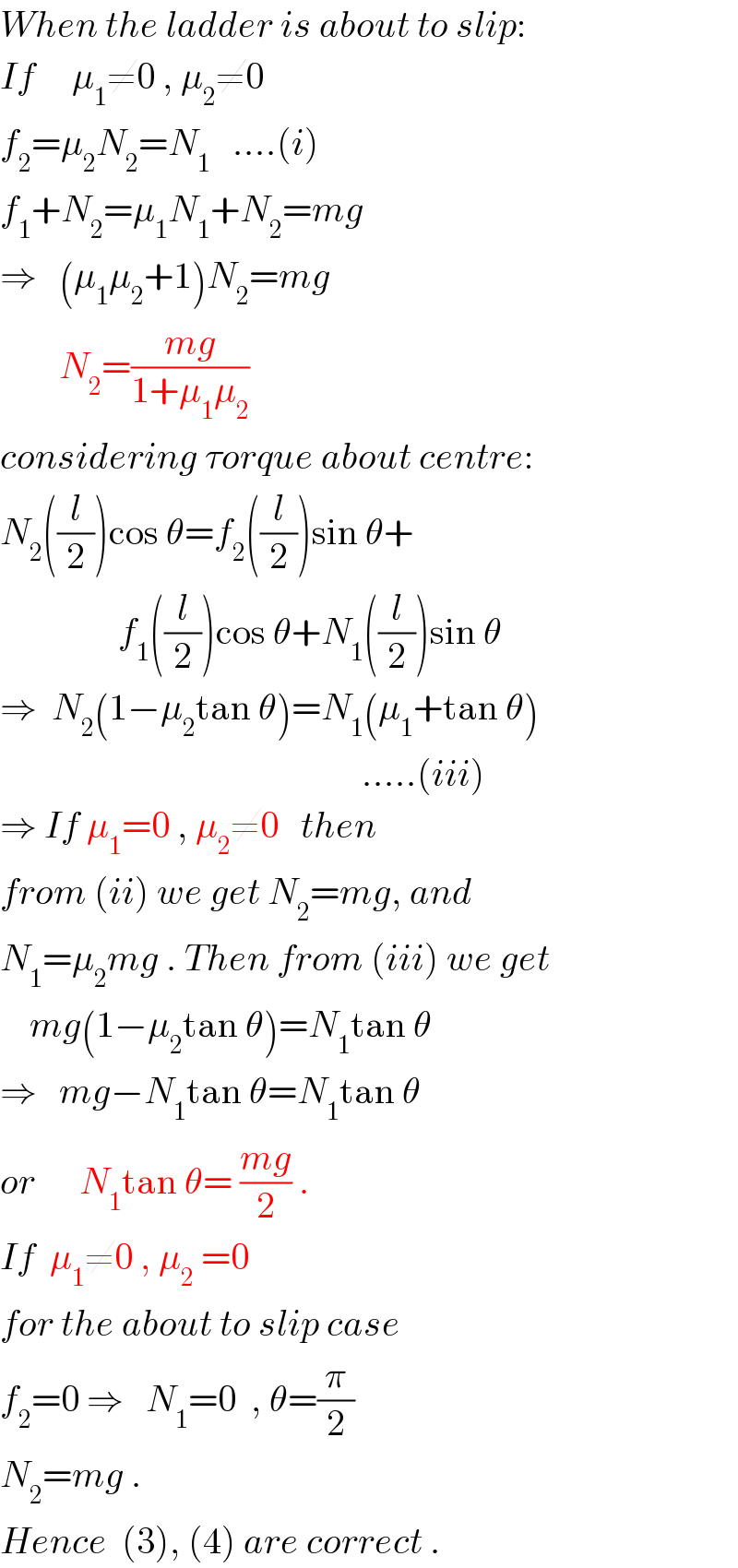
Question Number 22481 by ajfour last updated on 19/Oct/17

Commented by ajfour last updated on 19/Oct/17

$${Q}.\:\mathrm{22479}\:\left({Solution}\right) \\ $$
Answered by ajfour last updated on 19/Oct/17

$${When}\:{the}\:{ladder}\:{is}\:{about}\:{to}\:{slip}: \\ $$$${If}\:\:\:\:\:\mu_{\mathrm{1}} \neq\mathrm{0}\:,\:\mu_{\mathrm{2}} \neq\mathrm{0}\: \\ $$$${f}_{\mathrm{2}} =\mu_{\mathrm{2}} {N}_{\mathrm{2}} ={N}_{\mathrm{1}} \:\:\:....\left({i}\right) \\ $$$${f}_{\mathrm{1}} +{N}_{\mathrm{2}} =\mu_{\mathrm{1}} {N}_{\mathrm{1}} +{N}_{\mathrm{2}} ={mg}\:\:\: \\ $$$$\Rightarrow\:\:\:\left(\mu_{\mathrm{1}} \mu_{\mathrm{2}} +\mathrm{1}\right){N}_{\mathrm{2}} ={mg} \\ $$$$\:\:\:\:\:\:\:\:{N}_{\mathrm{2}} =\frac{{mg}}{\mathrm{1}+\mu_{\mathrm{1}} \mu_{\mathrm{2}} }\: \\ $$$${considering}\:\tau{orque}\:{about}\:{centre}: \\ $$$${N}_{\mathrm{2}} \left(\frac{{l}}{\mathrm{2}}\right)\mathrm{cos}\:\theta={f}_{\mathrm{2}} \left(\frac{{l}}{\mathrm{2}}\right)\mathrm{sin}\:\theta+ \\ $$$$\:\:\:\:\:\:\:\:\:\:\:\:\:\:\:\:{f}_{\mathrm{1}} \left(\frac{{l}}{\mathrm{2}}\right)\mathrm{cos}\:\theta+{N}_{\mathrm{1}} \left(\frac{{l}}{\mathrm{2}}\right)\mathrm{sin}\:\theta \\ $$$$\Rightarrow\:\:{N}_{\mathrm{2}} \left(\mathrm{1}−\mu_{\mathrm{2}} \mathrm{tan}\:\theta\right)={N}_{\mathrm{1}} \left(\mu_{\mathrm{1}} +\mathrm{tan}\:\theta\right) \\ $$$$\:\:\:\:\:\:\:\:\:\:\:\:\:\:\:\:\:\:\:\:\:\:\:\:\:\:\:\:\:\:\:\:\:\:\:\:\:\:\:\:\:\:\:\:\:\:\:\:\:.....\left({iii}\right) \\ $$$$\Rightarrow\:{If}\:\mu_{\mathrm{1}} =\mathrm{0}\:,\:\mu_{\mathrm{2}} \neq\mathrm{0}\:\:\:{then} \\ $$$${from}\:\left({ii}\right)\:{we}\:{get}\:{N}_{\mathrm{2}} ={mg},\:{and} \\ $$$${N}_{\mathrm{1}} =\mu_{\mathrm{2}} {mg}\:.\:{Then}\:{from}\:\left({iii}\right)\:{we}\:{get} \\ $$$$\:\:\:\:{mg}\left(\mathrm{1}−\mu_{\mathrm{2}} \mathrm{tan}\:\theta\right)={N}_{\mathrm{1}} \mathrm{tan}\:\theta \\ $$$$\Rightarrow\:\:\:{mg}−{N}_{\mathrm{1}} \mathrm{tan}\:\theta={N}_{\mathrm{1}} \mathrm{tan}\:\theta \\ $$$${or}\:\:\:\:\:\:{N}_{\mathrm{1}} \mathrm{tan}\:\theta=\:\frac{{mg}}{\mathrm{2}}\:. \\ $$$${If}\:\:\mu_{\mathrm{1}} \neq\mathrm{0}\:,\:\mu_{\mathrm{2}} \:=\mathrm{0}\:\: \\ $$$${for}\:{the}\:{about}\:{to}\:{slip}\:{case} \\ $$$${f}_{\mathrm{2}} =\mathrm{0}\:\Rightarrow\:\:\:{N}_{\mathrm{1}} =\mathrm{0}\:\:,\:\theta=\frac{\pi}{\mathrm{2}} \\ $$$${N}_{\mathrm{2}} ={mg}\:. \\ $$$${Hence}\:\:\left(\mathrm{3}\right),\:\left(\mathrm{4}\right)\:{are}\:{correct}\:. \\ $$
Commented by Tinkutara last updated on 19/Oct/17

$$\mathrm{Thank}\:\mathrm{you}\:\mathrm{very}\:\mathrm{much}\:\mathrm{Sir}! \\ $$
